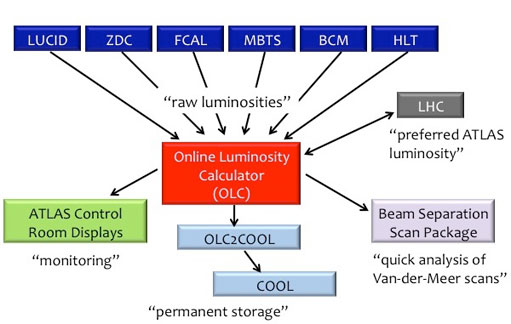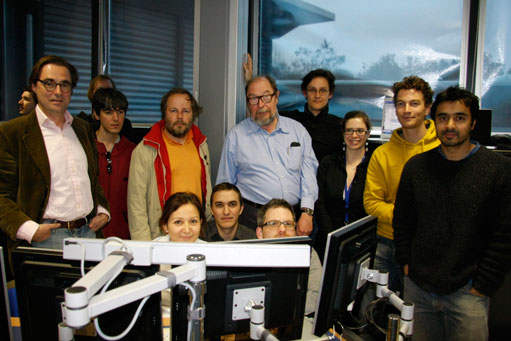
ATLAS e-News
23 February 2011
Every collision counts!
31 May 2010

And we are counting every one of them! Online luminosity monitoring is crucial for the LHC and the LHC experiments. This is the one quantity necessary to just about every measurement we make. ATLAS has six separate sub-detectors that are giving in total sixteen independent raw-luminosity measurements. This large number of different sources and formats needs to be handled in a coherent way. The raw values need to be calibrated, integrated over time, sent to online displays and last but not least stored for later offline analysis.
In principle anything that counts the number of interactions could be used for relative luminosity measurements though good acceptance, clear understanding of the efficiency and counting linearity with respect to the luminosity are all big advantages. Comparisons of results obtained with different detectors should allow the study of systematic effects. In Summer 2009 it was therefore foreseen that ATLAS would use six sub-detectors for such measurements:
- LUCID, a Cherenkov detector dedicated to relative luminosity measurements
- FCAL, the Forward Calorimeter
- ZDC, the Zero Degree Calorimeter
- BCM, the Beam Condition Monitors, placed at the Inner Detector
- MBTS, the Minimum Bias Trigger Scintillators, located at the LAr-Endcaps
- Vertex counting in the High Level Trigger (HLT)
Obviously a very heterogeneous set of detectors, with big differences in performance, acceptance and efficiency! Given the fact, that each sub-detector performs raw-luminosity determination via a different set of algorithms, we end up with a total number of sixteen individual measurements, all published at their own rhythm and in different formats. So how do we handle this variety of measurements in a coherent way?
A small group of people was formed to come up with the best strategy for this task. But given the tight schedule, with beams and first collisions planned for October 2009, this was quite a challenge!
It was agreed to implement an application, the “Online Luminosity Calculator” (OLC). The basic requirements were clear-cut. It needed to be able to collect data from the sub-detectors and from the LHC beam instrumentation. It had to calibrate the raw luminosities, perform time integration, and do the normalization. It also had to publish the results for online usage and permanent storage.
But how is the calibration of the raw-measurements performed? Most of the sub-detectors are just publishing hits and event counts. To translate these into luminosity, one needs to know the exact beam conditions, for example, how many colliding bunches are currently in the ring. To collect such information, the OLC is in direct communication with the LHC beam instrumentation. The actual calibration is then performed by applying efficiencies which are provided by the individual sub-detector groups. These efficiencies are either extracted from Monte Carlo or real data (although the absolute scale is still from Monte Carlo).
The OLC publishes the calibrated luminosities synchronously for all sub-detectors and algorithms in a coherent format on a so-called IS Server (IS stands for Information Service). Instantaneous measurements are published with the frequency of 1Hz, but they are also integrated over Luminosity Blocks, the time unit of ATLAS. The concept of Luminosity Blocks has already been explained in a previous ATLAS e-News article.
It is roughly 2 minute long, a time interval during which the luminosity can be considered to be constant. Additionally, the OLC publishes the beam currents and the LHC bunch-pattern in a format, consistent with the luminosities.
All Luminosity Block averaged and instantaneous values are sent to the Online Displays in the ATLAS Control Room. These displays enable the Luminosity shifter to monitor the luminosity accurately, including time trends. In this way, any inconsistency in the measurements from the different detectors and algorithms can easily be spotted.
During Van der Meer scans, the OLC output is also picked up by the beam separation scan package. In these scans the effective beam size is determined by shifting the two beams with respect to each other, while recording the event rate. Together with other machine parameters it is then possible to determine the absolute luminosity, which can be used for calibrating the relative measurements. These scans are also important for beam position optimization at the ATLAS interaction point.
But since we make16 luminosity measurements, you may wonder which one gives the official ATLAS luminosity? Out of the 16 luminosity values, the luminosity community chooses a "preferred algorithm" from one "preferred detector". This value is published as the "official ATLAS luminosity", sent to the LHC, and also displayed on the LHC Page 1 website. The choice for the preferred algorithm and sub-detector depends on the performance of each sub-detector, and can change with the actual running conditions. Right now it is the event counting algorithm from LUCID, one that requires a coincidence on both sides of the detector. The other 15 measurements serve as important cross-checks and as a fallback solution, in case the preferred one drops out.
The permanent storage of the online calculated luminosities and beam conditions is achieved by the online database archiving application OLC2COOL: It writes the Luminosity Block averaged OLC output to the COOL conditions database. Every quantity is labeled with the correct Run Number and Luminosity Block Number. In this way, any user can extract the online measured luminosity to the corresponding data set.
Even though the schedule was very tight, a first version of the OLC could be set up for the first collisions in December 2009. It was running with basic functionalities and was fed information from a sub-set of the detectors. The connection to the ATLAS Control Room displays was successfully established, and even a first beam separation scan was performed on December 11, which enabled us to test the infrastructure and communication with the LHC.
Nowadays the OLC is running with almost all foreseen functionalities and all sub-detectors are implemented. The output is successfully stored by OLC2COOL and the luminosities are constantly monitored in the ATLAS Control Room.
Of course there are still things to do – but thanks to the input of many people, the monitoring of the Online Luminosity is under constant improvement.

First online luminosity from 7 TeV collisions. The picture is showing the luminosity shifter desk in the ATLAS Control Room on the 30th March 2010. It covers only a small set of people working on online luminosity – the number of people involved is of course much higher.

Stefan MättigCERN/University of Hamburg
|